Contents
Bronze Clay and Copper Clays
One big note on these clays: That black stuff that often appears on these clays after firing is nothing more than oxidation: a chemical process that occurs when base metal clays are exposed to oxygen. To clean off the oxidation you can either use a radial bristle brush 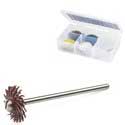 or drop it (after quenching it in water) in a pickle solution. If you don’t know what pickle is, FDJ Tools has a nice little article on it. A safe alternate to the commercially available pickles is to mix 1/4 cup of citric acid per a quart and 1/2 of distilled water. Sugarcraft.com (look under hard candy ingredients) sells a one pound jar of citric acid crystals for about $6.00. You can also find it in health food stores or chemical supply houses (ask for reagent citric acid). If you heat it in a crock, potpourri pot or stove top in a Pyrex baking dish (or other stove safe glass or pottery container) – ventilate. You can also use undiluted, reconstituted lemon juice. Heating it will make it work faster. As I’ve never used the lemon juice, I’m not sure of the concentration – experiment. Don’t forget to neutralize the pickle (whichever type you use) by boiling it in baking soda (small handful) and water (two cups) for a little while. Baking soda is a base and will neutralize acid. If you don’t neutralize the pickle – the acid will continue to work and will eventually dissolve your work. Not such a great idea! Rinse off the baking soda!
or drop it (after quenching it in water) in a pickle solution. If you don’t know what pickle is, FDJ Tools has a nice little article on it. A safe alternate to the commercially available pickles is to mix 1/4 cup of citric acid per a quart and 1/2 of distilled water. Sugarcraft.com (look under hard candy ingredients) sells a one pound jar of citric acid crystals for about $6.00. You can also find it in health food stores or chemical supply houses (ask for reagent citric acid). If you heat it in a crock, potpourri pot or stove top in a Pyrex baking dish (or other stove safe glass or pottery container) – ventilate. You can also use undiluted, reconstituted lemon juice. Heating it will make it work faster. As I’ve never used the lemon juice, I’m not sure of the concentration – experiment. Don’t forget to neutralize the pickle (whichever type you use) by boiling it in baking soda (small handful) and water (two cups) for a little while. Baking soda is a base and will neutralize acid. If you don’t neutralize the pickle – the acid will continue to work and will eventually dissolve your work. Not such a great idea! Rinse off the baking soda!
Timelines
2004 – Hadar Jacobson experiments with the first bronze and copper clays.
mid – 2008: The first version of Bronze clay was developed by Bill Struve of Metal Adventures.
2009: Metal Clay Adventures brings out Copperclay.
2009: Prometheus clay arrives.
September 2009: Aida Chemicals copper clay arrives (Art Clay)
December 2009: Hadar Jacobson launches her powdered versions of Bronze , Copper and Stainless Steel Clays.
Early 2010: Hadar Jacobson presented White Bronze Clay
June 2010: Hadar Jacobson brings out Pearl Gray Steel Clay
July 2010: Bill Struve of Metal Clay Adventures releases Fastfire BRONZclay.
Want to make your own clay? Yeah, really, you can make it at home! Here’s instructions from Del Feast at the Metal Clay Academy’s site.
Metal Clay Adventure’s Clay
Bronze clay hit the scene at the 2008 PMC conference. BRONZclay is 11% tin and the other 89% is copper, water and a “non-toxic” binder (as we don’t know what it is, it’s hard to tell). BRONZclay is available at RioGrande, Metal Clay Supply, Cool Tools, New Mexico Clay, among others. Celie Fago has a great story to tell about her first encounters with BRONZclay here.
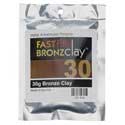 Recently, Metal Adventures came out with a quick fire version (which they are calling “fast-fire”) of BRONZclay. The big difference here is, obviously, firing time. Fastfire BRONZclay can fire in as little as two hours compared to the 4-9 hours required by regular BRONZclay. That’s a substantial savings in time. I just started working with this clay and find it very easy to carve. It has a very fine grit and reminds me of a very soft sandstone. While it’s easy to carve, it’s also easy to over carve it. FF Bronz clay is rather flexible and very fragile. It takes and holds patterns pretty well and my last three firings went perfectly. One note, Metal Clay Adventures notes that this clay MUST be fired with a SLOTTED lid and coconut shell carbon.
Recently, Metal Adventures came out with a quick fire version (which they are calling “fast-fire”) of BRONZclay. The big difference here is, obviously, firing time. Fastfire BRONZclay can fire in as little as two hours compared to the 4-9 hours required by regular BRONZclay. That’s a substantial savings in time. I just started working with this clay and find it very easy to carve. It has a very fine grit and reminds me of a very soft sandstone. While it’s easy to carve, it’s also easy to over carve it. FF Bronz clay is rather flexible and very fragile. It takes and holds patterns pretty well and my last three firings went perfectly. One note, Metal Clay Adventures notes that this clay MUST be fired with a SLOTTED lid and coconut shell carbon.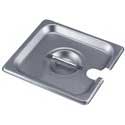 I just pushed the lid back a bit so that there was a gap – instead of buying an additional lid. I believe they also state this option in the instructions included in the packet.
I just pushed the lid back a bit so that there was a gap – instead of buying an additional lid. I believe they also state this option in the instructions included in the packet.
Coppr Clay by Metal Clay Adventures which is also available at Rio Grande, Metal Clay Supply, Whole Lotta Whimsy, New Mexico Clay, Cool Tools, etc.
Hadar’s Clay
Hadar Jacobson has developed a Bronze Clay, Copper, White Bronze, Steel and Pearl Gray Steel in powdered form available at her Textures store. The copper clay is too slumping/silky and I guess you could call it hard to work. I also had inconsistent firing results, most of the time. I had better firing results with the bronze. I really liked the pearl gray steel clay. But, I am very cautious about using it in my studio as steel, especially in a powdered form, can be very detrimental in a silver/gold smiths studio. It can contaminate other metal clays, get into the pickle (that cleans oxides from torch soldering) and copper plate my jewelry. So, be wary of working with this clay if you indulge in the other types of metal fun.
Prometheus Clays
 Odak, a Turkish company, carries Prometheus clay and has information on it’s use. You can purchase Prometheus Bronze and Copper Clays, as of this writing, at Prometheus Hobby. Prometheus has significantly changed their formulas and their clay is now very smooth.
Odak, a Turkish company, carries Prometheus clay and has information on it’s use. You can purchase Prometheus Bronze and Copper Clays, as of this writing, at Prometheus Hobby. Prometheus has significantly changed their formulas and their clay is now very smooth.
Art Clay Copper 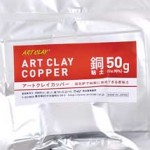 available at Art Clay World and other places.
available at Art Clay World and other places.
I’m just ordering some now to try out. I like the sound of it: 30 minute kiln firing, no carbon, torch firing, 10% shrinkage. If it works, it will be the one I use as I have yet to find a copper clay that I like.
Check out the great information on using BRONZclay from Cool Tools, written by Mardel Rein. Rio Grande has put out a PDF on working with their Bronz and Coppr clay. It’s a great source of information. On the bottom of Rio’s regular BRONZclay order page there is a short video. Facet Jewelry also has much knowledge to share on its Clays and Resins page. The Metal Clay Academy is a great source of information on all things metal clay.
Bronzclay videos to watch: Cool Tools. Prometheus has a video on firing their clay using their paper towel/fiber blanket system. Hadar Jacobson has a video on how to mix her clays.

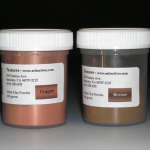
Hi Lori, I’ve never done it so, I will refer you to the experts: http://www.metalclayacademy.com/metal-clay-resources/downloadable-metal-clay-resources-and-tutorials/how-to-fire-metal-clay.html. Hadar Jacobson has a link on that page for firing base metals (which bronze is). Good luck and you could always do a little experimenting at home>?!?!?!? Take care and thanks for writing. Nancy
Can you torch fire Bronze clay? I have heard varying stories.
Hi Deby, I wish that I could help you with this problem but, I will have to send you to the manufacturers as I am not that familiar with this clay. I’ve only used it for very simple fired pieces. HobbyMaxiStore.com is the website for Odak, the manufacturer. Ozgur Aykoc is the person to contact. Here is the link: https://www.hobbymaxistore.com/. Their email is: info@odakhobi.com. They are very helpful and will, no doubt, help you solve your problem. Take care and good luck. Nancy
I am using Prometheus Bronze Clay.
I use the wrapping method. I am having difficulty with the clay coming out of the kiln and just falling apart. My instructions say to wrap & fire @ 700-750 for 30 mins which I am doing, why won’t it work for me I am a very patient & creative soul but this is testing me. I read some other instructions on a web site that say fire @ 820 should I be doing this?
Hi There,
I work with Promethus copper and Bronze clay. This time when I fired my bronze piece, it didnt convert to metal completely. I wrapped the piece in papaer towel with coconut carbon and the with fiber blanket. I fired it at 820 degree for half an hour. It was a big piece. When I started brushing it to remove the oxidation, certain parts broke and some of the parts were still in the clay form and started wearing out with water. i have fired some pieces before using the same method and temperature and the pieces were fired perfectly. I am so surprised that what went wrong with firing. Can you please help to understand the cause.
Also most of my copper pieces cracked after firing. I am so dissapointed at it really took long for me to make the pieces, but after firing they all got ruined. Can you please advice.
Thanks
Sanjeeta
Hello Angela, Wow, that sounds like a mess. Did you quench it right after firing? That removes a bit of the oxidation. Another technique is to re-heat the piece – either with a torch or in the kiln and then quench it. Of course – if there are stones or glass embedded in the clay – you can’t do it. The stones/glass will suffer from thermal shock and shatter. You can also pickle it afterwards for additional removal of oxidation. Is your pickle hot? That makes a big difference. If you pickle it, you should boil it is a mixture of baking soda and water for about 5 minutes to remove pickle that may be deep in the pores. One last technique is to use a abrasive disc like 3M’s Radial Bristle Discs (http://www.riogrande.com/Product/3M-Radial-Bristle-Disc-Master-Kit/332595?pos=9). I use these discs for all types of clean up and they are great for recesses and areas with intense patterning. Tumbling will only shine up the oxidation. Don’t do it – unless you want that look. Don’t worry, the piece is not lost. Let me know how it went and what worked for you. Thanks for writing. Nancy
Hello!
My husband and I have been experimenting with copper clay and bought the Prometheus clay. Our Kingpin 88 arrived today and we were so eager to fire our first piece. Unfortunately, even though their instructions says that we could fire without a pan and the coconut shell carbon, we still have a lot of oxidation on our item. It looks like a thin sheet of black that just won’t come off. We had immediately placed the piece in pickling solutions after firing but I’m not sure how to get the oxidation off, or if it’s even possible because although some of it came off, after 1/2 hour, it still has a lot of black on it. I hate that because it’s such a beautiful piece without the black. Would a tumbler work? We are also trying to wire brush but that isn’t working well either. Thanks for your help! You have some great info above. -Angela
Prometheus is no longer found at PMC Connection!!! Where can I find it in the states? I love it!!! It is so much easier than the other brands! No Carbon!!!!
Thanks for the correction. I hope you received my email thanking you. Don’t know where I got Greece from????
Odak is actually in Turkey and the owners are Turkish.